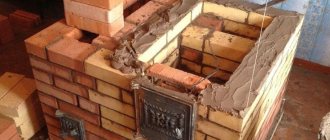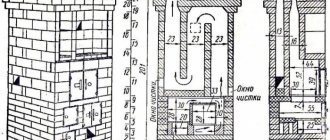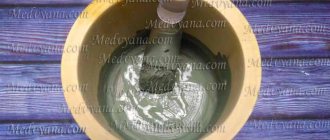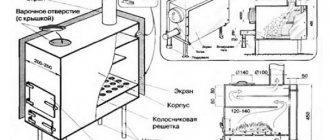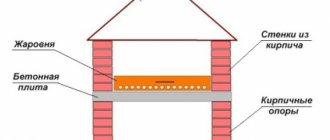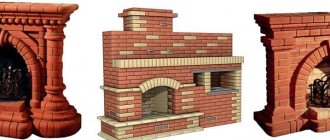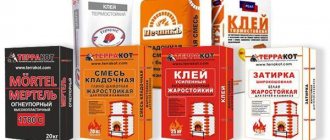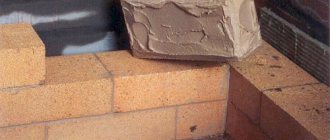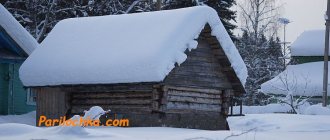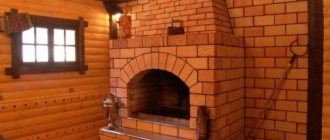What parameters are affected by the mixture for laying bricks?
A mixture of poor quality or inappropriate for operating conditions can cause very unpleasant consequences. The stove will either have to be constantly repaired, or completely redone taking into account the mistakes made.
The quality of the solution affects the safe operation of the furnace
How does a poor-quality masonry mixture manifest itself?
- Cracks in masonry joints. They are most quickly detected in places of maximum heating. The presence of cracks indicates that the strength of the furnace has decreased significantly.
- Smoke enters the room. A very dangerous phenomenon that requires immediate elimination. In winter, the stove is not dismantled; cracks have to be periodically sealed with mortar throughout the season. After a few days it falls out and the process needs to be repeated.
- The bricks are shaking. Such consequences are found near the firebox doors. Heavy cast iron structures are connected to bricks. If they are not strong enough, then the doors will wobble a lot when opening/closing. With such a problem, you can hold on to the heat, but you need to use the firebox very carefully and carefully.
If you use a low-quality solution, you will subsequently have to repair cracks in the slab
Rules for preparing and applying ready-made mixtures
The advantage of preparing masonry material from ready-made compositions is the ease of work. You will need a large container, a mixer or an electric drill with an attachment. The manual kneading method is also possible, but it requires physical effort. It is recommended to avoid excessive addition of water as... this will reduce the performance of the composition.
The solution must be prepared in parts as work progresses. The mixture is not allowed to harden, because repeated kneading will disrupt the structure of the raw material.
The manufacturer's recommendations regarding the proportions of water and dry material must be followed. The volume of liquid is also affected by the temperature in the room. In cool weather, less water is needed.
To prepare the composition, the dry mixture is poured into warm water. The mass is thoroughly mixed, the raw material should turn out creamy. The solution is allowed to brew for 1 hour, then thoroughly mixed again.
Ready-made installation compositions have a high moisture-holding capacity. When laying, no additional moistening of the blocks is required, which speeds up the work process and reduces drying time.
The elasticity of the solution allows for thin seams (2-4 mm). The walls acquire an aesthetic appearance and do not form cracks. When applying heat-resistant raw materials indoors, it is required to maintain a temperature of no less than +10°C and no higher than +35°C. The mixture is spread on blocks in a layer of 10-12 mm.
Recommended mixtures for laying a stove
The list does not include compositions with cement and gypsum. Now you understand that this is the worst option.
Table. Types of masonry mixtures for brick ovens
| Type of mixture | Brief description of physical and operational characteristics |
| Ready-made formulations | Modern mixtures include fireclay clay powder, sand and plasticizers. They are sold in bags, are easy to prepare, and perform their tasks very effectively. The only drawback is the relatively high cost. But stoves do not require a lot of mixture; the price of the solution does not have a noticeable impact on the cost of the facility. |
| They do it themselves. The master must have extensive practical experience to correctly select clay and sand, determine the optimal formulation, etc. This is a traditional solution, if the recommendations are followed, it fully meets the existing requirements of government regulations. As for the performance characteristics, they satisfy users in all respects. |
As an example, we will consider the process of preparing a mixture from ordinary clay.
Types of ready-made mixtures for laying stoves
Prices for fireproof mortar for stoves and fireplaces
Fireproof mortar for stoves and fireplaces
Optimal mixture composition
The consistency of the mortar for laying stoves should be creamy, thick and viscous. To prepare the composition, fatty clay is supplemented with 2 parts of sand. The proportions for clay raw materials of normal consistency and sand are 1:1. The quality of the mass must be checked by fastening 2 bricks together for testing. After 5 minutes, the structure is lifted by the upper part. A high-quality bundle will withstand 2-3 lifts. Lack of adhesion indicates a poor-quality composition.
Stove makers recommend supplementing the raw materials with table salt in the following proportions: 150 g of salt to 10 kg of clay mass. Cement, which is added at the rate of 1 kg of cement (grade M400) per 10 kg of clay, will improve the binding qualities of the material.
The laying of sections of the chimney located above the roof is carried out with lime-sand mortars due to the material’s resistance to moisture. Composition proportions: 3 parts sand, 1 part lime paste or quicklime, 3 volumes of water.
Sand
Kiln mixtures are made using pure river sand. Screened quartz white sand is optimal. Feldspar material with a yellowish tint is suitable for all stove elements except the firebox. Natural sand has greater bonding power than artificial sand. Before preparing the composition, the material is cleaned of impurities using a sieve, then washed with water.
Clay
Clay mortar for the stove is made from high-quality raw materials. Clay is a micro-grained mineral supplemented with silicon and aluminum oxides. The material is distinguished by its bonding ability, plasticity, strength, and hygroscopicity. The sum of the characteristics is determined by a single value - the fat content of the composition.
For laying stoves, medium saturation of raw materials is required. Excessively greasy composition will crack when drying. Raw materials unsaturated with minerals are also not suitable.
Practical tips for using the mixture
If you violate the generally accepted rules for laying stoves, then even with very high-quality mixtures you can get an outright defect. What do the professionals advise?
The quality of the furnace masonry depends not only on the mortar
- The clay should only be mixed with a special mixer; you can never achieve a homogeneous composition manually.
- The solution can be left for an unlimited amount of time. After drying, water is added and the composition is mixed. This cannot be done with cement-based solutions; once they harden, they cannot be corrected.
- Work is allowed only at temperatures not lower than +10°C. The bricks must be dry; the rate of moisture absorption does not affect the strength parameters.
- The first time the stove can be lightly heated no earlier than three days after the completion of the masonry. It is strictly not recommended to rush; if the recommendations are not followed, large cracks may appear through which smoke enters the room.
- To lay the outer row of the outer chimney, cement should be added to the mixture. Ordinary clay with sand is afraid of moisture and gradually erodes outdoors. Cement mortar does not react to the negative effects of natural precipitation.
For laying the chimney, use a solution containing cement.
Efflorescence may appear on poor-quality seams after the first fire, and white marks may be visible on the surface. This is a very unpleasant phenomenon and is removed over a long period of time. The efflorescence should be carefully scraped off, and then the surface should be trimmed with a damp cloth. Such actions will have to be repeated until the salts are completely eliminated.
How to remove efflorescence from the stove
The work of a stove maker requires not only theoretical and practical knowledge, but also great responsibility. This is one of the few construction works where no assistants are involved; all operations are performed by the master personally and bears full responsibility for the results of his work. Even a slight deviation from the recommended technologies becomes the cause of defects; to eliminate them, you need to lose a lot of time and financial resources.
Use of refractory concrete
The composition of refractory concrete includes specialized additives and mixtures that give the material greater strength when exposed to high temperatures.
During operation, heat-resistant concrete
It also acquires significant resistance to heat. A good positive quality is the fact that refractory concrete does not require very expensive special firing, and therefore is widely used in construction.
In terms of functionality, it does not differ from ordinary concrete and can provide complete safety and protection of your structure from overheating. Moreover, heat-resistant concrete can be used as a thermal insulation material.
Depending on the area of use, cellular, light or dense concrete
. A material is considered not heavy when its dry weight does not exceed 1500 kg/m3. To the base raw materials of slag Portland cement, Portland cement, aluminous cement or liquid glass, finely ground impurities are added, such as broken refractory bricks, lump fireclay, pumice, broken magnesite bricks, andesite and others. Additives help the hardening of heat-resistant concrete and form its heat-resistant qualities.
Heat-resistant concrete with phosphate and silicate binders
In other words, there is specialized heat-resistant concrete. This is when, in addition to the alumina-cement binder, a silicate or phosphate base is added to its composition. Heat-resistant concrete with a phosphate binder adheres better to other refractories, hardens faster and has greater strength when compared with concrete using alumina cement. The hardening agent is cement, talc, magnesium oxide. The filling is high-temperature materials: corundum, broken corundum and high-alumina refractories, chromites and chromium magnesites.
Heat-resistant silicate-bonded concrete is used in acidic environments. To increase hardness, sodium silicate, sodium fluoride, and phosphates are added.
The filler is quartz and high-silica fireclay. Due to its very high resistance to acids, heat-resistant silicate-bonded concrete is usually used for smoke removal in pickling baths, tanks, and pipe linings.
If you have come to the conclusion to build a barbecue, fireplace or stove in your house from refractory concrete with your own hands, then to save money during construction you can easily do it yourself. To do this, use a dry prepared mixture or mix the components using a special technology similar to the preparation of simple concrete.
Factory mixtures are made according to all standards and can ensure product quality. When using a dry prepared mixture, carefully read the instructions on the package and strictly follow them.
Production technology of refractory concrete
is divided into two options: if the structure will be exposed to moisture, do not add liquid glass; if the environment is acidic and dangerous, do not use Portland cement.
Set up the work site, make sure water is readily available and tools are clean.
Production of heat-resistant concrete
The typical composition of heat-resistant concrete includes: sand, gravel, slaked lime, refractory cement. Based on this, the ratios are 3:2:2:0.5. Pure filtered water requires 7.7 liters for 22.5 kg of mixture. Use a shovel to thoroughly mix the sand and gravel in a wheelbarrow or use a concrete trowel.
Then pour the mixture with water until it reaches the required consistency. Transfer the mixture to the finished mold or casting, level the surface with a spatula and remove excess concrete. The faster you work, the denser the solution will be.
To remove voids and get rid of air bubbles in the heat-resistant mixture, use a punch or use a jackhammer. Insert a drill into the wood part of the mold and work for one minute. Next, the mixture, which is already ready for use, needs to be covered with film and left for several days, sometimes sprinkled with water. Move the finished fire block indoors and then leave it for 25 days.
To make castings, use plywood. To easily remove the heat-resistant block, polymer ethylene is placed on the bottom of the mold, or at most greased silicone, which will not interfere with the evaporation of water from the surface of the block.
